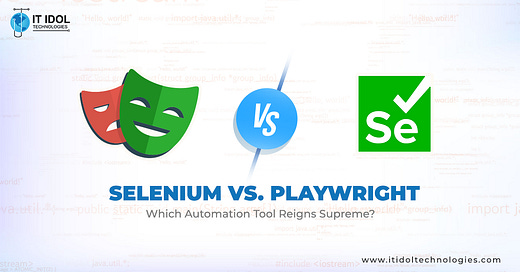Selenium vs. Playwright: Which Automation Tool Reigns Supreme?
In the fast-paced world of web development, delivering seamless user experiences is crucial. Automated testing plays a vital role in ensuring application reliability, efficiency, and performance. Among the top web automation tools, Selenium and Playwright stand out as powerful solutions for testing web applications. But how do you decide which one is right for your project?
This blog provides a detailed comparison of Selenium and Playwright, analyzing their features, performance, and use cases. By the end, you'll have a clear understanding of which tool best aligns with your testing needs.
What is Selenium ?
Selenium is one of the most widely used web automation testing tools, originally developed by Jason Huggins in 2004. It has since evolved into a robust suite of tools that enable cross-browser testing and automate web interactions efficiently. Selenium supports multiple programming languages, including Python, Java, and C#, making it a versatile choice for developers and testers.
Key Features of Selenium
Selenium WebDriver – Automates browser interactions for precise testing.
Selenium Grid – Enables parallel execution across multiple browsers and devices.
Selenium IDE – A simple record-and-playback tool for quick test creation.
Common Use Cases
Cross-browser testing to ensure compatibility across different browsers.
Regression testing to verify software updates don’t break functionality.
Automating repetitive tasks like form submissions and UI interactions.
What is Playwright?
Playwright is a modern end-to-end testing framework developed by Microsoft, designed to provide fast, reliable, and scalable cross-browser automation. Launched in 2020, it supports Chromium, Firefox, and WebKit, making it an excellent choice for testing web applications across multiple environments with a single API. Unlike traditional testing tools, Playwright offers auto-waiting and headless execution for efficient test execution.
Key Features of Playwright
Cross-browser automation – Supports multiple browsers with one API.
Auto-waiting mechanism – Reduces flakiness by waiting for elements dynamically.
API testing support – Enables automation beyond UI interactions.
Component testing – Ideal for modern front-end frameworks like React and Vue.
Common Use Cases
End-to-end testing to validate user workflows.
Component testing for UI reliability.
API testing to ensure backend stability.
According to Microsoft Playwright Docs, "Playwright enables reliable testing and automation across modern web applications with speed and efficiency."
Key Differences: Selenium vs. Playwright
When choosing between Selenium and Playwright for web automation, understanding their key differences is crucial. Below is a breakdown of how these two testing frameworks compare in essential areas.
1. Browser Support
Selenium: Supports all major browsers (Chrome, Firefox, Safari, Edge, and Internet Explorer).
Playwright: supports Chromium, Firefox, and WebKit with better cross-browser consistency but lacks Internet Explorer support.
2. Performance & Speed
Selenium: This relies on WebDriver, which can cause slower execution due to external communication.
Playwright: uses a direct API-driven approach, resulting in faster execution with built-in auto-waiting to reduce flakiness.
3. API & Language Support
Selenium: Supports Java, Python, C#, JavaScript, and Ruby, making it highly versatile.
Playwright: Primarily supports JavaScript/TypeScript but also offers Python, C#, and Java support.
4. Ease of Setup & Learning Curve
Selenium: Requires separate drivers (e.g., ChromeDriver, GeckoDriver), making setup more complex.
Playwright: Comes with built-in browser binaries, offering an easier setup and better debugging tools.
5. Community & Ecosystem
Selenium: Established in 2004 with large community support, extensive resources, and integrations.
Playwright: Newer but rapidly growing with modern documentation and better default automation capabilities.
Comparison Table: Selenium vs. Playwright
Both tools are powerful, but Selenium excels in broad compatibility, while Playwright is better suited for speed and modern web automation.
Real-World Use Cases & Scenarios
Choosing between Selenium and Playwright depends on your project's specific needs. Here’s where each tool excels:
Selenium Use Cases
Testing Legacy Systems – Works well with older web applications and Internet Explorer support.
Cross-Browser Testing at Scale – Ideal for large enterprise applications that require Selenium Grid for distributed testing.
Integration with CI/CD Pipelines – Easily integrates with Jenkins, CircleCI, and Azure DevOps for automated regression testing.
Handling Large Test Suites – Suitable for projects with extensive test cases that require parallel execution.
Playwright Use Cases
Modern Web Apps – Best for single-page applications (SPAs) built with React, Angular, or Vue.js.
API & Component Testing – Supports testing APIs alongside UI tests, making it effective for end-to-end workflows.
Real-Time Applications – Playwright’s auto-waiting and event-driven architecture reduce flakiness in dynamic apps.
Headless Execution & Performance Testing – Ideal for fast, headless browser testing in cloud environments.
Both tools have strong real-world applications, with Selenium being ideal for large-scale legacy testing and Playwright excelling in modern, high-performance automation.
Choosing the Right Tool: Factors to Consider
Selecting between Selenium and Playwright depends on several key factors:
Project Requirements – If you need extensive cross-browser testing and compatibility with legacy systems, Selenium is a strong choice. For modern web apps with dynamic content, Playwright offers better handling.
Team Expertise – Teams familiar with Java, C#, or Python may prefer Selenium, while JavaScript/TypeScript teams might find Playwright easier to adopt.
Budget & Resources – Selenium has a broader ecosystem with open-source integrations, while Playwright provides faster execution but may require additional learning.
Scalability & Maintenance – Playwright’s simpler setup and auto-waiting features reduce flakiness, whereas Selenium is better suited for large-scale enterprise automation.
Choosing the right tool depends on your project’s complexity, team skills, and long-term maintenance needs.
Conclusion
Both Selenium and Playwright offer powerful automation capabilities, but their suitability depends on your project needs. Selenium excels in cross-browser compatibility and large-scale enterprise testing, while Playwright stands out for its speed, modern web automation, and built-in features like auto-waiting and API testing.
For teams dealing with legacy systems and extensive test suites, Selenium remains a strong choice. If you need faster execution, seamless automation for modern apps, and advanced debugging tools, Playwright is a great alternative.
Need expert guidance? Contact a custom software development company for tailored automation solutions. Share your thoughts and experiences in the comments!




